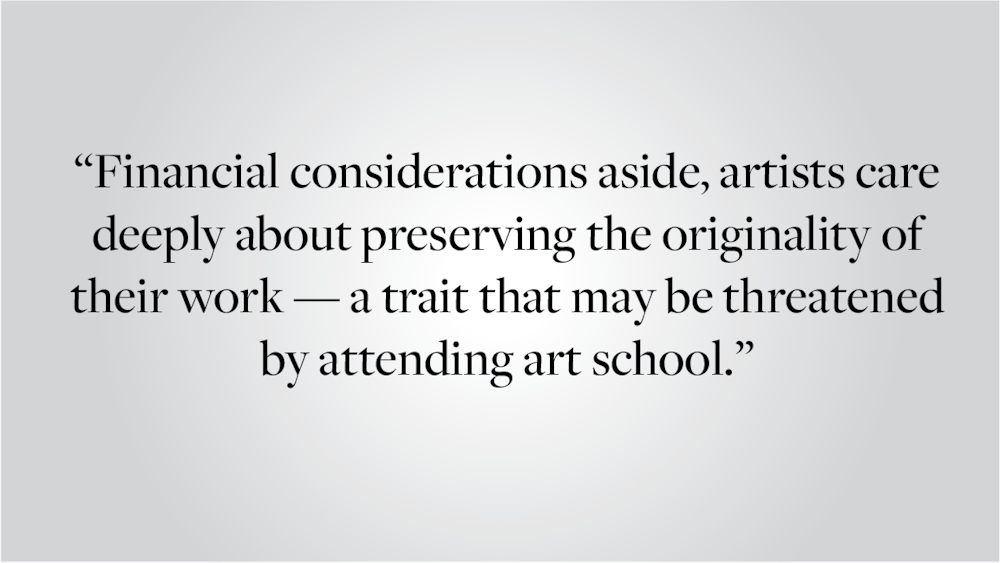This fall, millions of Americans packed their bags and kissed their parents goodbye as they left home to pursue a four-year college degree. Upon graduation, these students will join the nearly 40% of Americans who hold a bachelor’s degree. However, only a slim proportion of those — two million to be exact — have graduated with a degree in the arts, and of those two million, only 10% end up working as artists.
While many four-year graduates enter the workforce with a livable income, art degrees rarely offer a stable paycheck. Knowing this, most students who attend RISD, Julliard and their peer institutions aren’t focused on big money, but rather making the best art they can. If this is the case, then one must consider a simple question — do art school graduates make better art? Beyond the financial burdens, aspiring artists need to acknowledge the potential creative risks involved in enrolling in art school.
Although there are valuable aspects of a degree in the arts, spending $200,000 out of pocket on four years in a classroom is difficult to justify. RISD charges an average tuition of $45,000 after financial aid, meaning that students must pay upwards of $180,000 to obtain their degree. Although the design school is considered to be amongst the most elite art institutions in America, its tuition falls close to the average.
With this investment, students hope to build a foundational set of skills, joining a like-minded community that can launch them into a successful career as an artist. Despite these advantages, the reality is that working, degreed artists struggle to pay rent, earning a median income of $36,500, just above the $30,500 earned by those who skipped college to start their careers.
These data show that the financial gain from a degree in the arts is not enough to justify its large investment. Finances, however, only make up one piece of the puzzle. The full answer reaches beyond a simple cost-benefit analysis and explores the concept of creative returns.
To understand the true artistic value and limitations of art school, one must understand that many artists care more about making great work than they do profit. Prospective artists still enroll in art school despite the reality that their degree is likely to earn them much less than that of a liberal arts degree — around 35% less to be exact.
Financial considerations aside, artists care deeply about preserving the originality of their work — a trait that may be threatened by attending art school. A large part of art school curricula lies in the practice of theory and technique — learning the “dos” and “don'ts” of great art. However, true artistic innovation flourishes in the betrayal of these rules.
In practice, one must understand the pedagogical techniques cultivated by art schools, and how they might pigeonhole students into narrow-minded ideals. Trade school professors are masters of their fields — they are highly knowledgeable of the rules. Some may adhere to them, while others may have broken them in their own work. But, even the latter group — the “innovators” — have themselves created their own set of rules based on their counter-trend choices. Students are then graded based on their professors’ personalized rubrics, under the illusion that these strict artistic rules apply to all real world practice. Upon graduation, students subconsciously fall in line, subscribing to these rules in their work.
Now, picture an artist with no university-level training: a blank canvas of an artistic mind, with no subconscious perception of what is institutionally deemed as “good” work. This person has the freedom to create strictly from their imagination without respect to convention and established norms. They may end up being incredibly innovative, as the best artists do not simply try to break the rules, but instead create freely, without rules in mind.
A small 4-piece group from Liverpool called “The Beatles” became the Tom Brady of bands with little to no knowledge of music theory. Orson Welles, one of the most influential filmmakers of all time, never watched movies, because he was afraid of copying them.
For those art forms requiring a great degree of technique, art school certainly has its practical benefits. If you are trying to paint lifelike, 16th century-style portraits, or compose for a 40-piece orchestra, then art school might be for you. Still, four years of school can be destructive to both the wallet and one’s artistry. Instead of enrolling, most artists should consider simply diving in — starting to create.





